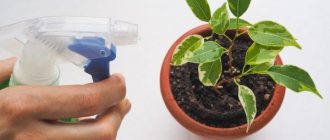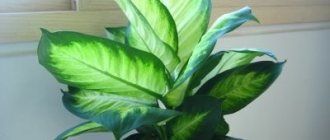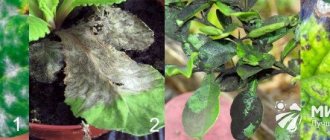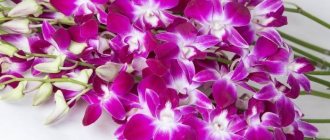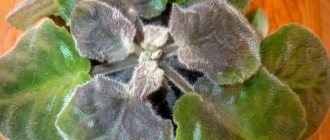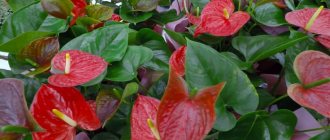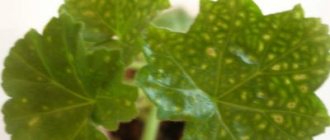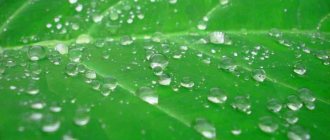Tips of anthurium leaves drying out
Often, gardeners are faced with the problem of the tips of anthurium leaves drying out, which causes reasonable concern.
The tips of dried leaves lead to a rapid increase in the area of damage to the leaf blade and complete loss of the leaf. The plant may lose all its leaves if you do not respond promptly and make changes to agricultural practices. Understanding the reasons why anthurium leaves dry out will allow for effective treatment. Dried tips of the leaves indicate insufficient air humidity in the room. Another equally common cause is poor aeration of the root system.
Treatment for anthurium with dry leaf tips involves more frequent spraying. A pot with a houseplant is placed away from heating radiators. Place a container of water next to the pot to increase air humidity.
Aeration of the root system depends on the composition of the soil and the material from which the flowerpot is made. Dense soil and insufficient drainage holes do not allow the roots to “breathe.” Anthurium should be transplanted into a clay pot
It is important to use a special composition for epiphytic plants for planting.
Other problems when growing anthurium
The size of leaves and flowers is affected by the age of the plant. The older the anthurium, the smaller and paler the flowers. The trunk becomes more bare every year as the leaves below die off. Some types of anthurium continue to grow luxuriantly, but with small rosettes, and some with a single rosette of leaves.
To help the plant continue to bloom profusely with large flowers, it needs to be rejuvenated. Using a sharp knife, cut the top of the anthurium so that you get a cutting with two or three aerial roots. Plant it in soil prepared in advance. In order for the cutting to develop better, before planting it can be placed in a growth stimulator for some time. You need to care for the cuttings systematically, spraying them with warm water.
Often gardeners are faced with the fact that anthurium not only dries out, but also does not bloom. This problem leads to:
- lack of lighting;
- incorrect temperature conditions;
- too high air temperature in winter;
- incorrect watering procedure;
- low humidity in the room;
- the presence of dry inflorescences on the plant.
Now you know why anthurium leaves turn black or yellow, and also what to do in such situations. The plant may also change leaf color to yellow, brown or another color due to improper care or pest attack.
Therefore, it is important to provide the flower with proper care, timely watering, fertilizing, and replanting as necessary. If you notice that the leaf blades of a plant are changing their color, do not ignore it.
It is important to determine the cause of the problem and eliminate it in time to save the anthurium.
Video: Stretched violets: what to do?
The Anthurium genus contains up to 900 (according to some estimates up to 1500) species and is deeply appreciated by lovers of indoor flowers of the Araceae family (this includes plants such as alocasia, philodendrons, monsteras, syngoniums, scindapsus, zamioculcas, dieffenbachia, aglaonemas, spathiphyllums, anubias, cryptocorynes, colocasia and etc.). All types of anthuriums are loved for their beautiful leathery, shiny, large leaves and unusually shaped flowers that resemble swallowtails.
Decorative species are usually grown at home, including Hucker's anthurium, Veitch's anthurium, crystal anthurium, climbing anthurium, which is used for vertical gardening. The most popular are Andre's anthurium and Scherzer's anthurium, in which the inflorescence is characterized by a pronounced veil.
Anthurium is a wayward plant. To grow it and maintain a well-groomed appearance, it is necessary to use special soils, which will, moreover, be filled with substrates (you can make them at home yourself or purchase them in specialized stores), have a drainage system, because this plant does not like to be flooded or dry out , therefore, a system of optimal soil care must be present. In nature, anthurium grows in loose soil with the remains of rotted wood, which is constantly ventilated and not oversaturated with moisture. However, at home it is recommended to use soil for orchids or violets (coal, peat, bark or sphagnum) with the addition of high-moor peat, perlite and leaf humus. Instead of high-moor peat, you can use store-bought peat, but do not purchase low-lying soil, because it is completely unsuitable for growing anthuriums.
If the rules for choosing and caring for the soil are followed, the plants will delight you with their extraordinary beauty, otherwise, if the soil is oversaturated with water, improper care, or failure to comply with the appropriate criteria for room care and location, the anthurium may “catch” a viral disease and suffer from rot in the soil. roots, stems, infestation with parasites. How to check if everything is ok with your anthurium? If you notice cracked leaves, inclusions of yellow spots, tubercles, white rot on the roots, yellowing, or falling leaves, then the rules for maintaining the plant have been violated.
How to propagate a plant?
When an anthurium is in an environment suitable for its growth, it, like all other flowers and plants, begins to reproduce. This happens by the appearance of small shoots – “babies” – near large plants. Their separation is the most common option for flower propagation. It is advisable to do this directly during transplantation. Very carefully, the shoot is separated from the adult plant using a knife, and the cut area is rubbed with charcoal. Next, the anthurium is planted in a separate pot according to technology
There is another method that involves propagation from the stem. To do this, the stem and leaf are placed in a container of water and covered with a glass jar to create an air dome. After some time, the stem will take root, then it will need to be planted in a pot.
There are cases of seed propagation of anthurium, but at home this procedure is extremely painstaking and almost impossible.
What to do if the anthurium has brown spots on the leaves, see the following video.
Why is this happening and what to do?
Incorrect temperature
Anthurium is a plant from humid, hot countries. In winter, the optimal temperature for flower viability is only eighteen degrees, and in summer, despite the flower’s homeland, it is considered normal if the mark on the thermometer does not exceed twenty-six degrees. At the same time, anthurium does not like drafts and easily freezes in them.
If, nevertheless, the leaves begin to dry out due to the wrong temperature, you urgently need to create comfortable conditions for the anthurium: move it to a colder/warmer place where drafts will not reach the flower - this is monitored especially carefully.
Important! Be sure to reduce watering if the flower freezes slightly.
Illiterate watering
Having discovered that the tips are drying out due to the quality of the water, due to too many salts and heavy metals in it, you should not hesitate and switch to watering with another liquid with a better composition. An option is to infuse water: running water is poured into a bottle and left for two to three days. After a few days you can use it for watering: the composition improves, the liquid becomes less harmful. The main thing is that the water is at room temperature.
Pests
Anthurium is often “attacked” by mites, scale insects or mealybugs. Having found traces of insects on the stem, leaf blade, leaf petioles and axils, gardeners treat the anthurium with a soap solution. A gram of nicotine sulfate is added per liter of water. A day after treatment, the plant is washed with clean water. Beforehand, flower growers take care to protect the soil from waterlogging during the procedure.
A solution of pyrethrum, tobacco tincture or Karbofos can also help in the fight against parasites.
Fungus
It affects not only the leaves, but also the root system of the plant. When dry spots appear all over the leaf, the anthurium is removed from the pot and its roots are examined (we talked more about the reasons for the appearance of various spots on anthurium leaves here)
If they suddenly turn from white/light brown to brown or black, and the tissues become soft and slimy, then the plant is replanted, but before that it is important:
- remove soil residues;
- cut off damaged leaves;
- trim fungus-affected roots to healthy tissue;
- treat the cuts with crushed coal;
- treat the entire plant with a fungicide.
After moistening the soil, excess liquid is poured out, and before the next watering, wait for the top layer of soil to dry out.
Potty doesn't fit
Anthurium, the reason for the drying leaves of which was the lack of free space in the pot, and therefore the lack of oxygen, requires an emergency transplant. The new container should be two to three centimeters larger in diameter; it is advisable to add more coarse fraction to the soil: cones, pieces of brick or charcoal.
If desired and at the right time, the plant is rejuvenated and replanted.
Lack or excess of fertilizers
Violation of the feeding regime and their quantity leads to drying out of the tips of anthurium leaves. If this happens, it is necessary to check the recommended rate and amount of fertilizers usually given to the plant.
Excess nutrients in the soil cannot be corrected. In this case, the plant is transplanted into “poorer” soil and the recommendations for the use of fertilizing are strictly followed. The deficiency is compensated by increasing the dose of fertilizing.
The soil is not suitable
Too dry soil or, conversely, waterlogged soil can lead to unpleasant consequences for anthurium, including its death
Therefore, it is important to follow the watering regime and not overwater the anthurium. It is necessary to promptly remove excess accumulated water from the pan, monitor the quality of drainage and dry air
A quickly drying substrate indicates dry air. Then they try to moisten it in every possible way:
- spray the plant with water at room temperature;
- wipe the leaves (but do not allow drops to linger on the leaf plate - the anthurium can cause a burn);
- shade the plant, because the sun's rays, especially direct ones, not only harm the leaves, but also dry out the soil.
In summer, it is recommended to place the pot on a wide tray with damp coarse sand or pebbles. When watering with water from a tap, the composition of the soil can change, and an excess of fertilizers has the same effect. In the first case, the anthurium is watered with water that has been infused for several days, in the second case it is replanted and then the amount of fertilizing given is monitored.
On our website you have the opportunity to learn about what diseases can affect anthurium and why its leaves may turn yellow.
Flower age
Most often, leaves turn yellow due to aging. Age-related changes affect more the foliage that is located closer to the ground surface. In this case, the yellowness spreads throughout the entire leaf, due to which elasticity and juiciness are lost, the leaves become brown. After some time, they disappear on their own if they are not removed first. If the plant is well cared for and properly cared for, the loss of old foliage will not harm the flower, because healthy young leaves will begin to grow at the top.
Yellowing leaves do not benefit the plant, they only take away its strength; it is better to cut them off in time. If you remove the old leaves, the flower will begin to develop and become attractive. To cut dead leaves, it is recommended to use scissors or a knife treated with alcohol so as not to introduce infection into the stem. Sprinkle the cut area on the trunk with crushed charcoal. When the leaves have turned yellow but have not lost their juiciness, they cannot be torn off by hand so as not to injure the main stem, so use a sharp tool for this purpose.
Popular articles Is it possible to eat the fruits of virgin grapes?
Causes of blackening of anthurium leaves
Improper care and temperature conditions of the plant often lead to the leaves of anthurium turning black. To figure out what reason affected the plant, the article will analyze in detail all the possible ones.
Diseased anthurium
Diseases
A variety of diseases can appear in both indoor and garden crops. Anthurium is not immune to diseases either. If the leaves have dried out, spots or plaque have appeared, then such a plant should go into quarantine until it recovers, so as not to harm the other flowers. Treatment should be started as soon as possible.
The first possible problem is rust. It begins to appear first on the stems and leaves, looking like brown spots of different sizes. As a result, the leaves fall off, and after some time the plant completely disappears. This happens in dry air.
Septoria is a fungal disease that actively develops in warm and humid environments. Yellow spots and brown edges appear, the leaves dry out quickly.
Soil fungi infect roots, which rot and wither. The appearance is associated with the use of infected soil, or the plant was already infected upon purchase. Overwatering and improper drainage in the pot are also causes.
For your information! If you do not treat the flower by removing the affected parts, then only a stump will remain from the plant.
Powdery mildew appears as a white coating. There is a difference between false and real. The latter is treated with fungicidal agents. It appears due to high humidity at high temperatures, sudden temperature changes, and improper care. When pale small pimples appear, it is necessary to begin treatment for mealy fungi.
Fusarium and gommosis are also found in anthurium. The reason is poorly disinfected soil.
Affected leaves
Anthurium can also turn black from the caescospora fungus. It is not so dangerous for the plant, but it can affect its appearance. It first appears in the form of yellow spots, which then turn brown, eventually the leaves dry out and fall off.
Pest attack
Another reason why anthurium leaves turn black is an attack by pests. The main parasites are scale insects, aphids, thrips, and spider mites.
Scale insects are tiny, armored bugs that are very difficult to spot. It is necessary to carefully care for the plant. These bugs deprive the indoor flower of energy, and as a result it withers and dies.
Thrips larvae can be seen on the back of the leaf, they look like black dots. They can infect a plant at any time of the year, but are more active in spring and summer. Larvae and adult thrips are also dangerous.
Important! All flowers affected by pests must be quarantined. The main signal of aphid appearance is leaves that are sticky to the touch.
Aphids are insects that multiply very quickly throughout the plant.
The main signal of aphid appearance is leaves that are sticky to the touch. Aphids are insects that multiply very quickly throughout the plant.
If a cobweb is seen on a flower, it means that a spider mite has settled on it. It leads to drying of all parts of the anthurium - leaves, flowers, shoots.
Wrong fertilizer
Black spots may appear from the use of fertilizers that contain a large amount of calcium. A lack of boron, zinc and iron and an excess of calcium lead to rapid aging of the plant.
Anthurium needs to be fertilized once every 3 weeks in spring and summer. These flowers are very sensitive to both an excess of lime and an excess of minerals. Therefore, fertilizing should be diluted.
Improper watering
Leaves darken at the edges if not watered correctly. It is unacceptable to water with cold tap water and with a high lime content. In summer, water with warm water at room temperature; in winter, the water temperature should be 18 °C.
Watering
Lack and excess of anthurium nutrition
If the plant has slowed down and its young leaves are smaller than those that opened earlier, the anthurium is likely suffering from a nutrient deficiency. A lack of basic elements, such as nitrogen, phosphorus or potassium, causes anthurium leaves to turn brown. A similar effect can be expected if the substrate lacks calcium or magnesium.
To feed anthuriums, liquid ready-made products are used, which are used weekly to restore a damaged plant, using a 25% concentration of that recommended by the manufacturer. When the pet gains strength, it needs to be fertilized every two weeks.
Sometimes not only a deficiency, but also an excess of fertilizers causes the development of yellow and brown spots on anthurium leaves. If there is an overdose of fertilizing, it is better to replant the plant in new soil, having first washed the root system.
What other spots may appear on anthurium and why?
The appearance of uncharacteristic spots on anthurium leaves indicates a disease of the species. It is possible to understand the cause and decide on treatment only after a thorough examination of the leaf plate.
Yellow spots
Yellowing of the leaf blade can occur when the plant is infected with chlorosis. It appears due to a lack of the following microelements: iron and magnesium. For treatment, you should remove the damaged leaves and urgently apply a complex fertilizer enriched with the necessary substances to the soil.
Yellow spots
On a note! It is possible to make an accurate diagnosis by the appearance of the leaf. With chlorosis, the veins remain green, and the leaf turns completely yellow.
Black spots
If the transplant procedure was carried out incorrectly or an unsuitable substrate for this species was used, black spots may appear on the anthurium.
The soil for this species is selected taking into account the individual preferences of the plant. For example, intended for bromeliads or orchids.
Leaf blackening
White spots
When anthurium is infected with powdery mildew, a white coating appears on the leaves.
This disease occurs at high temperatures and high humidity in the room.
This disease is easily treated in the early stages with ordinary fungicides.
Powdery mildew
How to properly care for anthurium to avoid brown spots
Why do hydrangea leaves turn yellow and the edges dry out - causes and treatment
In order for anthurium to delight with lush flowering and a juicy, green tint of glossy leaf plates, it must be properly cared for, following a number of recommendations:
- A suitable place to place a flowerpot with a plant is partial shade. Lighting should be plentiful, but diffuse.
- Temperatures in summer are up to 25 °C; in winter, anthurium will be comfortable at temperatures from 14 °C to 16 °C.
- Drafts are detrimental to the plant; they should not exist.
- Watering is carried out with soft, warm water. Frequency in the summer months - 2 times a week, with the onset of cold weather once every 7 days. The water drains from the pan after 15-20 minutes.
- The humidity in the room should be high. To ensure comfortable growth of the plant, it must be sprayed frequently.
- Fertilizing is introduced 2 times a month. Mineral complex or organic fertilizers are used.
- It is recommended to make the soil yourself, mixing 1 part peat and 2 parts each of leaf soil and humus.
Anthurium will thank you for proper care with its beauty.
Attention! When watering and spraying, it is necessary to avoid getting water on the inflorescences.
Anthurium is a magnificently beautiful plant with lush flowering. Despite the fact that it is considered rather capricious to grow, it does not require the creation of specific conditions. The appearance of brown spots on the leaf blades indicates that the plant has not been properly cared for. You can revive anthurium if you create a comfortable environment for it and eliminate the factors that provoke the disease.
What to do if anthurium leaves are covered with brown spots
If the leaf plates of the plant begin to turn brown, you need to determine what exactly led to the appearance of this symptom and begin to treat the anthurium:
- Incorrectly selected soil characteristics - replanting in the right soil.
- Sunburn - moving the pot to partial shade.
- Incorrect watering - adjusting the watering schedule.
- Pest attack - use of folk remedies or insecticides.
- Damaged roots - replanting with removal of bad roots.
Additional Information! The effect of a draft on the plant can lead to the appearance of brown spotting. When ventilating the room, it is recommended to take the anthurium to another room.
In order not to encounter diseases, it is necessary to immediately take proper care of the anthurium.
Yellow spots
Leaves turn yellow in winter due to lack of light. This phenomenon can also be caused by watering with water containing chlorine, as well as heavy metal oxides. If you want to avoid yellowness, it is recommended to water the plant with rain, melted water or pre-settled water at room temperature. If water accumulates in the pan, the roots will begin to rot and the leaves will turn yellow. It is necessary to moisten the soil moderately and remove excess liquid from the pan. A flower in a small pot may also produce yellow leaves. Then it must be transplanted into the largest container.
What to do to prevent diseases and pests?
The foliage turns yellow and falls off after fungal diseases. The most common:
- septoria;
- downy mildew;
- rust;
- anthracnose
Disease prevention includes
- regularly wiping the leaves with a damp cloth;
- creating comfortable humidity by spraying water from a spray bottle;
- maintaining the correct temperature.
Moist, non-drying soil is a favorable environment for fungi and putrefactive bacteria. Anthurium does not like both insufficient watering and excess moisture.
Due to the aging of the flower, brown spots and drying of the leaves are considered normal. It is necessary to eliminate errors in care and ensure normal growth conditions. When brown spots appear due to fungus and pests, the flower is treated with special preparations. Prevention of diseases and preservation of the attractive appearance of anthurium is achieved with good care and maintenance.
Previous
Diseases What to do if the buds of an indoor hibiscus fall off? Reasons why this happens Next Diseases Why does the Crassula shed its leaves and die? How to save your favorite plant?
We reanimate anthurium after mistakes in care
Many gardeners misunderstand the advice of maintaining high humidity for anthurium and begin to flood the plant. The result of such care is rotting of the roots, which manifests itself in various spots on the leaves.
Yellowing and drying of the edges of all leaves is immediately caused by excessive dry air. Often appears on anthurium at the beginning of the heating season. Treated by increasing humidity: additional spraying or a tray with wet expanded clay.
Yellowing and drying of the edges of the leaves is associated with dry indoor air
Deformation of leaves and flowers occurs in very dry soil and air. The plant does not have enough moisture and therefore young leaves and flowers unfold clumsily and deformed. Corrected by regulating watering.
Leaves and flowers open deformed in low humidity conditions
Yellowing of leaves. A symptom of several diseases at once.
- prolonged waterlogging of the roots, as a result of which part of the root system has rotted and the leaves lack nutrients - requires urgent replanting of the plant with the removal of rotten parts of the roots and planting in fresh soil;
- watering with chlorinated water - if it is not possible to water with rain or melt water, then leave ordinary water for several days in an open container;
- too large a dose of fertilizer - treated by spilling soft water and stopping fertilizing for 1 month;
- insufficient nutrition - use mineral fertilizers for flowering plants;
- insufficient lighting - mainly manifests itself in winter; the plant needs additional lighting with lamps.
Black tips of leaves. Excess calcium salts in tap water or hard water. Nothing can be done about crippled leaves, and young leaves will grow healthy after changing the water for irrigation to soft.
Various brown dry spots, holes on the leaves. This is a sign of a root system disease due to hypothermia, watering with cold water, or improper soil. You should move the plant to a warmer place and let the soil dry. Very often, owners of newly purchased anthuriums face this problem during the cold season. Even a short run to the car with this delicate plant can damage the leaves.
Reviving a plant that has suffered from rot
In cold and wet soil, anthurium roots often rot, the leaves begin to wither, dry out, and fall. If the plant is so neglected that not a single living leaf remains, then there is very little chance of resuscitation.
- The remaining plant is pulled out of the soil and gently washed in warm water.
- By examining the remaining roots, you can understand the extent of the disaster.
- If there are growth points on the light roots, then there is a chance to revive the anthurium.
- The plant is dipped in a disinfectant solution (or a light solution of potassium permanganate) for 15–20 minutes and then dried.
- Transplant into a pot the size of the roots with soil for anthuriums.
- Place in a warm place, limit watering until new leaves appear, then water carefully.
Saving an anthurium that has lost its roots
Various rots and infections often begin with rotting of the roots. And sometimes there is nothing left to save, but if the leaves and trunk of the plant are alive and without signs of mass disease, then you can try to root the upper part of the anthurium with aerial roots.
- Cut the plant down to living tissue, anoint the cut area with green paint, and dry for one or two hours.
- Plant the top in anthurium soil.
- Cover the aerial roots with damp sphagnum moss.
- The plant will reach the ground with its aerial roots and the plant will grow again.
Saving a frozen flower
If the leaves of the anthurium are slightly frozen, then a healthy plant will be able to recover. It is much worse if the anthurium was watered shortly before and the roots were exposed to hypothermia. All damaged leaves should be cut off, the plant should be moved to a warm room and sprayed with the HB-101 vitalizer solution. If the plant gets worse in the next days, it means the roots are damaged, and you should immediately replant the plant, cutting off all rotten areas, and treat the cut areas with cinnamon. The stimulator HB-101 can be sprayed and watered on the plant to strengthen the immune system.
Video - disease prevention
An important prevention of anthurium diseases is regular inspections of the plant, which are carried out by wiping the leaves. Then you will definitely not miss the warning signs of the onset of the disease and will be able to treat the plant in time
And in order for it not to get sick, follow the conditions of detention.
What are Anthurium diseases and the causes of their occurrence?
Violation of sanitary standards
The root cause of diseases is the owner’s attitude towards the purchased indoor plant. The flower needs time to adapt to new conditions. The plant requires individual observation to exclude infection.
To keep your flowers healthy, you need to isolate all newly purchased indoor plants from other crops for 2 weeks and keep them in quarantine conditions. During this period, healthy plants adapt and continue their growth and development. Patients will show external signs of the disease.
Disease groups
Diseases of indoor plants are divided into 2 groups: non-infectious and infectious.
Non-infectious diseases are the result of a violation of the maintenance of a flower in conditions that do not meet its requirements. Such diseases do not affect other plants. When the source of the disease is eliminated, they recover without causing damage to other crops.
Infectious diseases cause pathogenic infections that necessarily affect other plants. Changing hosts, pathogenic fungi, bacteria and viruses multiply quickly and in a short time can destroy almost all nearby plants.
What anthurium looks like: photo
In the photo in our gallery you can see what this flower looks like. It is very beautiful and is an evergreen.
. Anthurium comes from the tropics, and its flowers have a special bizarre shape, which is why it is often called the flamingo flower.
Anthurium is very popular among amateurs and professional flower growers. It looks unusual in itself, and it can also be used in different ways in different flower arrangements and bouquets. If desired, you can find photos of examples of such combinations.
Another feature of the plant is that it can stand cut in a vase for several weeks in a row.
However, there are a number of anthurium diseases that affect the leaves of the plant. They cause owners a lot of trouble. Most gardeners believe that it is better to prevent them than to treat them after the fact.
Plant care
The air around the plant should be well humidified. It needs to be sprayed a lot and often, and sometimes the foliage needs to be wiped with a damp cloth. To strengthen and develop the growth of adventitious roots, you need to cover the stems with moss. If you comply with all the requirements, the anthurium will bloom magnificently all summer.
In spring and summer, the flower grows, it needs to be fed, fed every 15 days, alternating organic and mineral fertilizers. The flower is replanted annually in the spring (if the base of the flower is more than 25 cm wide, replant it once every six months).
There are many reasons why flowers can become pale and small. This can be either a consequence of improper care or one of the signs of illness. Before taking active action, you need to find out the cause, and then effectively eliminate it.
What to do to save a flower
Saving a plant should begin with proper care of it, and then carry out those procedures that correspond to the type of disease.
In the case of a fungal disease or infection with bacteria or viruses, self-salvation is unlikely. Therefore, first of all, they get rid of all the leaf blades that are burned so that the infection does not spread to other house flowers.
The appearance of a gray coating on flowers, leaves, as well as redness of the lines and tips indicates a disease with gray mold. Young and newly transplanted anthuriums are more often infected. This is mainly a consequence of excessive watering, poor drainage, ignoring the removal of dry and dead parts of the plant, and neglecting to ventilate the room.
When septoria disease develops, it is necessary to spray the leaves with a chemical fungicide that contains a large amount of copper. If rust develops, it is worth spraying the bush more often, increasing the humidity in the room, and the affected greenery is cut off and burned.
To cure anthracnose, it is necessary to reduce watering and spray with copper fungicides. You can also add the chemical preparation Abiga-Pik to the soil substrate.
Note! If the flower does not respond to treatment, then it is burned so as not to infect other indoor plants in the house. To eliminate Fusarium wilt, you will have to treat the plant with copper insecticides and spray the soil substrate with gliocladin
It is best to get rid of all the soil; before replanting, place the plant briefly in a weak solution of potassium permanganate and plant it in fresh soil. The soil is disinfected
To eliminate Fusarium wilt, you will have to treat the plant with copper insecticides and spray the soil substrate with gliocladin. It is best to get rid of all the soil; before replanting, place the plant briefly in a weak solution of potassium permanganate and plant it in fresh soil. The soil is disinfected.
Shchitovka
If a scale insect is detected, it is necessary to immediately carry out mechanical cleaning and apply insecticidal preparations. These agents are also used when fighting thrips.
Having discovered a spider mite at an early stage, you can give the flower a warm shower. If there are a lot of insects, then special preparations are used against this parasite. Treatment for this parasite will take a long time. Be sure to remove cobwebs and wipe the pot and window sill.
Important! The difficulty is that the remaining larvae live for a long time and can appear again even after a year. Therefore, it is necessary to periodically treat the affected plant and those specimens located next to it with soapy water.
Fungal diseases
As mentioned above, anthurium is a moisture-loving plant, so it has a high chance of becoming infected with mycoses. These are diseases caused by microscopic fungi that love moist environments.
Downy mildew (peronospora)
Whitish, yellowish spots appear on the leaves of anthurium, so familiar to gardeners. Cucumbers are often affected by this disease. The formation of gray spores can usually be observed on the reverse side of the leaf.
The source of this common disease is a microscopic fungus that is extremely sensitive to air humidity. The main condition for getting rid of this parasitic fungus is a decrease in air humidity in combination with the use of contact fungicidal preparations (Topaz, Acrobat).
Rust
The disease affects anthurium leaves. Chlorotic spots of a rusty hue appear on the outer surface, and active sporulation occurs on the lower surface. Just as in the case of downy mildew, the main method of combating and preventing leaf rust is maintaining optimal air humidity. For prevention, you can use biological fungicides, for example, Albit, Alirin, Fitosporin.
An anthurium leaf affected by rust must be treated with a fungicide.
Fusarium wilt
This type of mycosis inhibits the entire plant. The fungal nature of anthurium wilting is revealed by a pinkish-white coating that forms on the root collar. The causative agent of the disease is species of fungi of the genus Fusarium.
Unfortunately, Fusarium infection occurs in many ways, including through water and air. And the fungal spores are extremely tenacious and resistant to high temperatures and chemicals. Therefore, the main thing in the fight against fusarium is prevention, for example, adding the antifungal drug Glyokladin to the soil. Systemic fungicides Vitaros, Rovral, Fundazol have also proven themselves well in the fight against fusarium.
Fusarium wilt affects the entire plant
Septoria
This common fungal disease appears on the leaves as brown spots, sharply outlined by a yellow rim. Subsequently, the leaves wilt and the plant dies. The main treatment is treating anthurium with copper-containing fungicidal preparations (Bordeaux mixture, copper sulfate, Kuproxat).
Brown spots with a yellow rim on anthurium leaves are a sign of septoria
Anthracnose
Another disease of anthurium that is fungal in nature. The leaves begin to dry out and become thinner. Dry brown spots may appear from the edges or in the middle of the leaf blade. If urgent measures are not taken, the plant will dry out quite quickly and soon die.
With anthracnose, anthurium leaves begin to dry out at the edges
Treatment should be carried out using systemic fungicides (Fundazol, Acrobat, Ridomil Gold). It is also necessary to treat the soil containing fungal spores with fungicidal preparations. If the anthurium could not be saved, the remaining indoor plants should be protected. The fungal spores are extremely tenacious, so the vacated pot must be heated. If this is not possible, then you will have to get rid of such dishes.
Late blight
Anthurium is quite rarely affected by late blight; nightshade plants are still more often affected by this disease. Despite this, if you notice small purple-brown spots on the leaves, you need to take immediate action. Late blight develops very quickly and affects the root system, dooming the plant to rapid death.
The best option for controlling late blight is to use systemic fungicides. These include Fitosporin-M, Fundazol, Alirin-B, Previkur. In this case, you will definitely have to replace the soil, rinse the roots thoroughly under water, and heat treat the pot or replace it with a new one. The roots can also be treated with a weak solution of potassium permanganate.
The next reason for yellowness is the size of the pot
A large pot is death for anthurium. Moisture will accumulate at the bottom of the pot, and thereby provoke rotting of the roots, which leads the anthurium to death. In order to save the plant, you must:
- Choose a medium-sized pot (not too small, but not too small).
- To transplant a flower, you first need to cut off the rotten ends of the roots.
- Root sections must be treated with wood charcoal powder and allowed to dry.
- Cover the bottom of the pot with small pebbles or expanded clay
- Next, add fresh soil.
Anthurium loves warmth and good lighting. The light of the sun's rays also has a detrimental effect on the flower. He does not tolerate this, so the green leaves also turn yellow from ultraviolet radiation and spots appear on them. If the flower is on the windowsill, then it is impossible to avoid sunburn. Yellowed areas and spots on leaves are burns. At best, diseased leaves dry out and fall off, and at worst, the flower will wither.
How to avoid this and save the plant, but at the same time provide the necessary light? It is necessary to find a place in the house with good lighting, where direct sunlight will be reduced to a minimum.
Growing a tropical flower
Temperature also has an effect on flowers. You cannot keep the plant in a room where the temperature can reach below +10 degrees. It is not recommended to leave anthurium in a draft or on a windowsill in the winter, as this will lead to frostbite. Anthurium is resistant to temperature changes, but it is best to keep it in a warm place. Then the risk of yellow areas appearing will be reduced.
The above reasons are the consequences of improper care. In addition, there are diseases of anthurium, which is why color changes and drying of leaves appear.
- Septoria blight (anthracnose) is a disease that is transmitted from plant to plant. At the same time, the leaves turn yellow and dry out. Saving the plant in this case is quite difficult.
- Chlorosis is an infectious disease that occurs due to a lack of magnesium and iron. Yellowish, green (dark) or brown spots appear on the leaves, but the veins of the leaves remain green. To cure such a disease, it is necessary to use chylates, which contain both magnesium and iron.
- Gray rot appears in case of high humidity or frequent watering. Therefore, it is necessary to control the frequency and amount of watering. In this case, brown shades and spots appear.
- Rust on the leaves manifests itself as spots on the upper part of the leaf, and spots containing powder with spores form on the lower part.
- Fusarium is a fungal disease that affects leaves. They turn yellow, dry out and wither, and eventually fall off altogether. The disease is transmitted from other plants or through the soil in which the flower grows.
Fungal plant disease
Violation of growing conditions.
When growing anthuriums, it is necessary to take into account the lighting in the room ; if there is a lot of it and there is direct sunlight, they should be shaded. Or move them to a more different place. Be sure to take into account the temperature regime for growing anthurium.
Most anthuriums prefer warmer growing conditions; some can tolerate lower temperatures. It is necessary to pay attention to planting anthuriums and their transplantation. During such events, the plant experiences stress. Since its growing conditions are violated and your anthurium has to get used to the new conditions for some time after planting/transplanting .
Watering anthurium and feeding is perhaps the main point in growing. All types of anthurium are not allowed to overdry the earthen ball; they also react painfully to excess moisture. If the norms and characteristics of watering are violated, problems with the appearance of diseases may arise . Pests can also cause harm .
Regardless of the reasons that arose when growing anthurium, any change or violation of conditions is primarily reflected in the appearance of leaves and flowering. The leaves may turn yellow, become spotted, simply begin to fall off, and may be affected by pests and diseases. The decorative component may also be lost if it becomes cramped in its pot and it has outgrown it too much.
The falling of leaves on an anthurium does not mean that it is dying or sick. It is necessary to take into account the natural death of leaves during development and growth.
Temperature
Temperature is very important, especially considering the tropical origin of anthuriums. Maintaining a stable and constant temperature is the key to good development. If the air is dry, the tips of the leaves may dry out. With sudden changes in temperature, which can be caused by drafts or differences between the heating and the window frame, problems with leaves and inflorescences also arise.
Solution to the problem: avoid sudden temperature fluctuations. Avoid drafts (especially when ventilating the room). Try to choose the very place in which your anthurium will feel ideal. If the air is dry, we use air humidifiers or wet spraying; you can also wipe the leaves with a damp cloth. When spraying flowering anthuriums, try not to get moisture on the inflorescences, otherwise they will begin to become stained.
Anthurium leaves turn yellow - it is necessary to find out the reasons and reconsider the growing conditions.
Planting and transplanting
When purchasing an anthurium, it must be transplanted to a permanent place. If your anthurium is old enough and its roots no longer fit into its pot, it should be replanted. Young. First, we take it out of the pot, and then plant it in a new one. Any disturbance in the root system is always reflected in its leaves - they begin to either dry out and fall off, or curl, dry out and fall off. Especially considering the fragility of the roots of anthuriums.
Solution to the problem: when planting or replanting, we try to minimize disturbance to the roots. If you have purchased a plant, carefully remove it from the pot and without breaking the earthen lump, place it in the same condition in a new pot. Try not to disturb the integrity of the root system that has already formed and is intertwined with the soil. Damp soil holds roots together better than dry soil. When planting or transplanting, the roots can be treated with a root formation stimulator (kornevin). When watering, you can use products such as epin, zircon.

